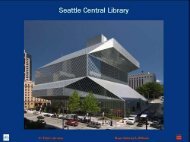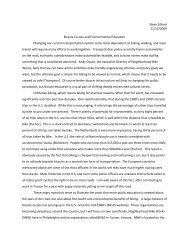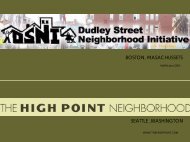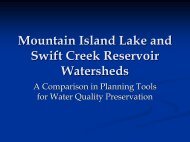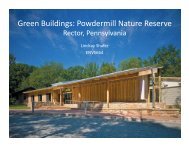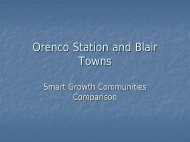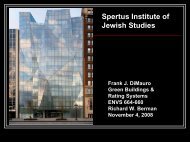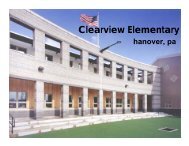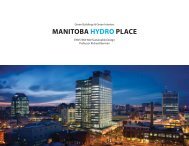Bahrain World Trade Center - Greendesignetc.net
Bahrain World Trade Center - Greendesignetc.net
Bahrain World Trade Center - Greendesignetc.net
Create successful ePaper yourself
Turn your PDF publications into a flip-book with our unique Google optimized e-Paper software.
<strong>Bahrain</strong> <strong>World</strong> <strong>Trade</strong> <strong>Center</strong>
Receiving multiple awards in the area of sustainability (2006 LEAF Award, The Arab<br />
Construction <strong>World</strong> for Sustainable Design Award, a 2008 ‘Best Tall Building Award’, an honorable<br />
mention in the 2009 NOVA) 1 , the <strong>Bahrain</strong> <strong>World</strong> <strong>Trade</strong> <strong>Center</strong> (BWTC) serves as a revolutionary<br />
model for innovation in green design as the first skyscraper in the world to embed industrial wind<br />
turbines within its building’s structure. The BWTC is situated on the Manama waterfront (<strong>Bahrain</strong>’s<br />
capital city) bordering northern Qatar in eastern Saudi Arabia in the heart of the region’s financial<br />
hub (about an hour’s car journey from Dubai). The Kingdom of <strong>Bahrain</strong> is made up of an<br />
archipelago of 33 island- the largest being <strong>Bahrain</strong> island- with an entire country only spanning an<br />
area of 700 square kilometers and a population just under 700,000. <strong>Bahrain</strong>- one of 33 islands- has<br />
long been regarded as the financial and banking hub of the Middle East.<br />
2<br />
1 The LEAF award (formerly The Emirates Glass LEAF Award) serves as an international architectural prize that<br />
recognizes architectural design in both private and public sectors of any building in the world. Operated by a Forum<br />
known as the Leading European Architects founded in 2001, this private association like the Arab Construction <strong>World</strong><br />
for Sustainable Design Award is operated by private entities without governmental regulation and oversight. The NOVA<br />
Award is an annual award governed by the Construction Innovation Forum (CIF) since 1989, to acknowledge<br />
innovations proven to provide significant advances that have had significant effects on construction to improve quality<br />
and reduce cost.<br />
2 <strong>Bahrain</strong> <strong>World</strong> <strong>Trade</strong> Centre, Manama, <strong>Bahrain</strong>. Designbuild-<strong>net</strong>work.com. http://www.designbuild<strong>net</strong>work.com/projects/bahrain/<br />
Accessed 2009.
Thus, the investment in such an innovative and revolutionary skyscraper should be<br />
understood as a product of an emerging private demand in sustainable design and construction. The<br />
building however, should not be construed as being situated in an extremely ‘busy’ or ‘metropolitan’<br />
environment with a range of neighboring structures and buildings. This will become important in<br />
understanding both the genius of its innovation and potential limitations of this type of design.<br />
Origins<br />
A member of the <strong>World</strong> <strong>Trade</strong> <strong>Center</strong> Association, the BWTC was fully backed and well<br />
financed with institutional investors but required a construction feat unaccomplished by any<br />
engineer or architect. The original impetus for the integration of wind turbines between the twin<br />
towers was strictly architectural, but soon developed as a sustainable solution. The wind climate in<br />
the Arabia Gulf prompted designers to utilize the concept of wind turbines in large-scale buildings.<br />
Previous research and attempts at integration turbines into failed to materialize due to high costs<br />
associated with such an adaptation of building design. Such endeavors would increase project costs<br />
up to 30%. However, designers from Atkins Architects and Norwin turbine specialists 3 were able to<br />
design an integrated turbine system that required only a 3% premium on project costs. This<br />
combination of a favorable natural wind system alongside creative design and lowered construction<br />
costs make the BWTC an important step toward innovated cost-effective designs. 4<br />
Technology<br />
The BWTC introduces an array of technologies to become the kingdom’s first intelligent<br />
building. “SMART” technology is integrated throughout both office towers. The SMART<br />
technology utilizes Intelligent Building Management Systems (IBMS) to monitor operational, facility<br />
3Included among the “20 Best Big Companies to Work For 2008”, Atkins Architects plans, designs and facilitates the<br />
delivery of complex capital programs for clients in both public and private sectors all across the world. They represent<br />
the largest engineering consultancy in the United Kingdom and the world’s 5 th largest design firm. Norwin Wind<br />
Turbine Technologies is a Denmark based engineering company focused on turbine development with operations all<br />
over the world and most currently in China and India.<br />
4 <strong>Bahrain</strong> <strong>World</strong> <strong>Trade</strong> <strong>Center</strong> Press Release. <strong>Bahrain</strong> WTC. Accessed 2009
and infrastructure management. These systems optimize energy use in heating, cooling, lighting, and<br />
security functions. The towers are also equipped with a structured cabling system (SCS) that<br />
integrates all forms of surveillance, data, and energy use with all operating systems. Security at the<br />
BWTC includes the latest CCTV surveillance and monitoring systems equipped to provide tenants<br />
with crisis management and disaster recovery emergency protocols. The building also includes “the<br />
automation of visitor management from parking to building admission including that for VIPs, a<br />
reservation management system for shared building facilities, an online helpdesk for maintenance<br />
requests and servicing and web-based billing enquiry systems.” 5 6<br />
5http://www.menareport.com/en/business,/198880<br />
6 <strong>Bahrain</strong> <strong>World</strong> <strong>Trade</strong> <strong>Center</strong> Press Release. <strong>Bahrain</strong> WTC. Accessed 2009
Structural Details<br />
The BWTC will primarily service business tenants in its office spaces in the two wind sail<br />
shaped towers. The three ground floor levels will accommodate a MODA shopping mall, food<br />
courts, retail dining, a business complex, and access to parking.<br />
Resource Efficiency<br />
The structure boasts a host of<br />
environmentally sensitive designs and energy<br />
saving features contributing to reducing carbon<br />
emissions. Each individual office in the towers<br />
has its own energy meter allowing each<br />
individual tenant and occupant to control their<br />
energy use and monitor usage and costs.<br />
Certain areas provide deep gravel roofs<br />
that provide ki<strong>net</strong>ic insulation, while balconies<br />
to the sloping elevations with overhangs that<br />
provide shading. Dense concrete core and floor<br />
slabs will level loads and reduce peak demand<br />
with associated reductions in air and chilled<br />
water transport systems. 7<br />
To minimize energy lost to cooling and ventilation, buffer zones were incorporated between<br />
outside environments and air-conditioned spaces. The buildings and adjoining complex is cooled by<br />
a highly innovative air conditioning and cooling system using chilled water (see figure above). This<br />
setup allows for optimal efficiency and cost savings and provides an environmentally sound<br />
alternative to conventional cooling systems through the recycling of water (discussed later)/<br />
Examples also include adjacent car parks to reduce solar air temperature and solar gain. 8<br />
7 <strong>Bahrain</strong> <strong>World</strong> <strong>Trade</strong> <strong>Center</strong> Press Release. <strong>Bahrain</strong> WTC. Accessed 2009<br />
8 Solar gain commonly referred to as solar heat gain or passive solar gain refers to the increases in temperature in either a<br />
space, structure, that results from solar radiation.
The building uses double-paned low-leakage windows with the ability to be opened. 9 This<br />
provides a mixed mode operation with the option to open or close windows according to seasonal<br />
and climate changes.<br />
Sewage Treatment<br />
According to Karolides, “in most cities, up to 10% of everything that is flushed down the<br />
toilet escapes the treatment plant and ends up in waterways,” and that often, “the first goal for more<br />
sustainable sewage systems is to reduce the amount of effluent that needs to be treated in the first<br />
place with water-efficient plumbing fixtures.” 10 In congruence with Karolides’ recommendations, the<br />
<strong>Bahrain</strong> WTC provide water and air transport systems (water pumping, piping, fan systems) that<br />
employ systems which require less initial start-up and maintenance energy. The water system’s piping<br />
structure also uses a dual drainage system that distinguishes between clean and wastewater for water<br />
treatment purposes. This also allows for water recycling within the <strong>Bahrain</strong> WTC towers themselves<br />
and diverting sewage, wastewater, and solids through an isolated sewage treatment system. The<br />
flushing systems are also completely electronic with flow restrictors that optimize water usage and<br />
provide more sanitation. Decorative pools in actuality serve as reflection pools at the building<br />
entrances to provide local evaporative cooling 11 . Surrounding all this are solar powered road lighting.<br />
9 Double-paned glass or windows consist of two facing glass panels in a frame separated by a small space (.5 -1 inch<br />
wide) often filled with nontoxic gases like argon to improve insulation. Depending on the window specifications,<br />
double-pane windows usually have R-values above 2 and can account for a 10-25% reduction in heating and cooling<br />
bills.<br />
10 Karolides, 15<br />
11 Evaporative cooling refers to a physical phenomenon where the evaporation of a liquid cools the surrounding area’s<br />
air and objects nearby.
Wind Turbines<br />
The most impressive innovation however, is the ground-breaking incorporation of wind<br />
turbines between the two towers as a source of renewable energy. The BWTC stands 787 feet high<br />
(50 stories) as a twin tower complex with three bridges each holding their own 39-meter diameter<br />
wind turbine. Each turbine has the capacity to generate 225kW of energy totally 674kW. These wind<br />
turbines operate roughly 50% of the time and provide 11% - 15% of the entire structures total<br />
power consumption (1.1-1.3 MWh/year). 12 The turbines are placed between the buildings, with the<br />
sail-like forms of the towers creating a concentrated flow of wind to power the turbines. As <strong>Bahrain</strong><br />
experiences periodic droughts and dust storms, in the case of severe weather and wind conditions,<br />
the turbines are designed to automatically slow down and have the blades pivot to avoid any volatile<br />
and potentially dangerous wind forces beyond the engineering threshold of the turbines.<br />
The shape and curvature of the two towers acts as<br />
an airfoil and funnels sea breeze from the Arabian<br />
Gulf between them. Servicing as airfoils, the two<br />
buildings can divert wind to create greater wind<br />
speeds. These turbines convert ki<strong>net</strong>ic win energy<br />
into mechanical energy in the form of electricity.<br />
Referring to the diagram, the towers’ elliptical<br />
forms and sail-like profiles act as airfoils, creating a<br />
negative pressure zone behind, thus accelerating<br />
the wind velocity between the towers into the path<br />
12 equivalent to providing lighting for approximately 300 home annually
of the turbines. Because wind speeds vary with height, the engineers had to develop a plan to<br />
normalize turbine speeds to avoid collapse and structural strain on the two towers. The designers<br />
came up with a tapered shape that can adequately adjust for these varying wind speeds. Even with<br />
higher wind speeds at higher altitudes, the turbines still have nearly constant vertical velocity<br />
profiles. The exact curvature and airfoil created also allows for any wind coming within a 45 degree<br />
angle to either side of the central axis (area between the two towers) will create a wind stream<br />
perpendicular to the propellers, significantly increasing the turbines ability to harness wind streams.<br />
For the BWTC, horizontal axis wind turbines are used where rotors must be placed facing<br />
into the wind, making the positioning of the turbines between the two towers of utmost importance.<br />
A horizontal axis wind turbine does have its advantages and disadvantages. Mentioned earlier, the<br />
angle of the blades can be adjusted to accommodate and optimize for the most efficient use of wind<br />
conditions. These blades can also be “pitched” in the event of strong winds to minimize stress. On<br />
the other hand, wind turbines require constant smooth wind flows. With the BWTC’s three<br />
elevations of turbines, performance of the lower turbines may be inconsistent as wind speed and<br />
direction tends to be more variable closer to the ground. From a cost standpoint, turbine production<br />
has not yet kept up with demand and prices have skyrocketed over 60% in the past three years with<br />
industrial orders fully booked up almost a year in advance with no signs of slowing in demand.<br />
The positioning of the BWTC has also been a topic of argument regarding environmental<br />
sensitivity. Though coastal locations are usually windy 13 and good sites for turbine installations, wind<br />
farms in these locations often jeopardize environmental aesthetics and certain natural ecologies<br />
(birds). 14<br />
13 A primary source of wind convection comes from the differential heating and cooling of land and sea over the course<br />
of 24 hours. Winds at sea level carry more energy that winds of the same speed in mountainous regions because of<br />
denser air at sea level.<br />
14 <strong>Bahrain</strong> <strong>World</strong> <strong>Trade</strong> Centre, Manama, <strong>Bahrain</strong>. Designbuild-<strong>net</strong>work.com. http://www.designbuild<strong>net</strong>work.com/projects/bahrain/<br />
Accessed 2009.
Conclusions<br />
There is no doubt that the <strong>Bahrain</strong> <strong>World</strong> <strong>Trade</strong> <strong>Center</strong> tackles many key criterions of<br />
resource efficiency and green design. But despite the many successes, the BWTC still has many<br />
shortcomings in terms of sustainability. One must remember that the original drive for the BWTC’s<br />
sustainable design came from a somewhat aesthetic and architectural incentive, using its design as<br />
simply a symbol of sustainable development and design solutions. In no way should one downplay<br />
the brilliance of the building’s design, engineering, or sustainable approach, but simply keep in mind<br />
the heavy architectural emphasis of its origins.<br />
Sustainable development and “true” green building as Karolides describes, “is a holistic<br />
approach to programming, planning, designing, and constructing (or renovating) buildings and sites.<br />
It involves analyzing such interconnected issues as site and climate considerations, building<br />
orientation and form, lighting and thermal comfort, systems and materials, and optimizing all these<br />
aspects in an integrated design.” 15 To categorize the entirety of the BWTC as a “true green” initiative<br />
and project simply isn’t true. The concept design of the BWTC was inspired by the traditional<br />
Arabian “Wind Towers”. The intent and purpose behind installing wind turbines- albeit green- was<br />
not “holistic” with sustainability at the core of the buildings concerns. Issues of transportation and<br />
accessibility often conflict with notions of sustainable urban design and infrastructure development<br />
relying solely on private automobiles. Construction also used the most cost-effective (cheap)<br />
materials and processes regardless of environmental impact with no cradle-to-grave assessments.<br />
Most shockingly, according to a recent paper by Shaun Killa and Richard F. Smith (Design Director<br />
and Principal Architect for Atkins) on the technical proficiencies of the BWTC, they even cautioned<br />
that, “This building is not intended to be a low carbon emission solution by European and other<br />
world-wide standard,” and only, “reduce carbon emissions when compared to other buildings in<br />
the Middle East.” 16 Even with the array of sustainable features, the lack of independent certification<br />
(LEED or otherwise) and standardization (in which one could grade its performance) severely<br />
jeopardizes the BWTC’s label as a sustainable project applicable to other scenarios.<br />
Ultimately, while the building’s limitations does raise certain questions and environmental<br />
concerns, one should appreciate and understand this revolutionary design as a pioneering step<br />
toward sustainability and green design through the potentials of modern engineering and<br />
architecture.<br />
15 Karolides, 4<br />
16 CTBUH 8th <strong>World</strong> Congress 2008
Works Cited<br />
Karolides, Alexis. Green Building: Project Planning & Cost Estimating .Kinston, MA: construction<br />
Publishers & Consultants, 2002.<br />
Killa, Shaun and Richard F Smith. Harnessing Energy in Tall Buildings: <strong>Bahrain</strong> <strong>World</strong> <strong>Trade</strong> <strong>Center</strong> and<br />
Beyond. United Arab Emirates, Dubai. 2008<br />
<strong>Bahrain</strong> <strong>World</strong> <strong>Trade</strong> Centre, Manama, <strong>Bahrain</strong>. Designbuild-<strong>net</strong>work.com. http://www.designbuild<strong>net</strong>work.com/projects/bahrain/<br />
Accessed 2009.<br />
<strong>Bahrain</strong> WTC Wind Turbines 2009 NOVA Award Nomination 15. <strong>Bahrain</strong> WTC: First Ever<br />
Integration of Large-Scale Commercial Wind Turbines into a Building. http://www.cif.org/noms/2009/15_-<br />
_<strong>Bahrain</strong>_WTC_Wind_Turbines.pdf. Accessed 2009<br />
BWTC Press Release. <strong>World</strong>’s First Integrated Wind Turbines Inaugurated in<br />
<strong>Bahrain</strong>.http://74.125.93.132/search?q=cache:jKoOl4uYlbYJ:www.cif.org/noms/2009/15_<strong>Bahrain</strong>_WTC_<br />
Wind_Turbines.pdf+bahrain+WTC+pdf&cd=4&hl=en&ct=clnk&gl=us&client=firefox-a Accessed 2009<br />
<strong>Bahrain</strong> <strong>World</strong> <strong>Trade</strong> <strong>Center</strong> Press Release. <strong>Bahrain</strong> WTC. Accessed 2009<br />
<strong>Bahrain</strong> <strong>World</strong> <strong>Trade</strong> <strong>Center</strong> announces plans for kingdom’s first intelligent buildings. MENA<br />
Report. http://www.menareport.com/en/business,/198880. Accessed 2009<br />
The <strong>Bahrain</strong> <strong>World</strong> <strong>Trade</strong> <strong>Center</strong> Official Website. 2009.http://www.bahrainwtc.com




